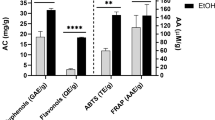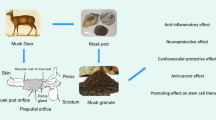Abstract
Kratom is a popular ‘legal high’ mainly constituted by alkaloids extracted from the Mitragyna speciosa plant with mitragynine (MG) as the dominant active substance. The increasing use of Kratom for recreational purposes has alerted risk assessment bodies of the lack of information on the real composition and its potential health risks. The present study aimed to determine and compare the MG composition of 13 commercial products of Kratom sold online and in “smartshops”, by gas chromatography–mass spectrometry. For the first time, the cytotoxicity induced by pure MG and Kratom, extracts was evaluated in in vitro models of human intestinal (Caco-2) and neuronal (SH-SY5Y) cells after 6 and 24 h. Genotoxicity was also evaluated in intestinal Caco-2 cells following 24 h of exposure to subtoxic concentrations using the comet assay. The obtained results revealed an inconsistency between the information (‘power’) provided in labels and the MG content. Cytotoxicity tests revealed a concentration-dependent decrease in cell viability in both cellular models, with the SH-SY5Y cells being more sensitive to the Kratom extracts. The resin and the ‘powered extracts’ were the most cytotoxic samples, with IC50 values significantly lower than the leaf extracts and pure MG (P < 0.0001 vs. leaf extracts and MG). In addition, significant DNA damage was observed in Caco-2 cells exposed to these extracts but not to pure MG, which suggests that other substances present in the extracts or interactions involving Kratom components might be responsible for the observed effects.



Similar content being viewed by others
References
EMCDDA (2012) The EMCDDA annual report 2012: the state of the drugs problem in Europe. http://www.emcdda.europa.eu/. Accessed Mar 2015
EMCDDA (2013) European Drug Report 2013: trends and developments. http://www.emcdda.europa.eu/edr2013. Accessed Mar 2015
EMCDDA (2014) European Drug Report 2014: trends and developments. http://www.emcdda.europa.eu/edr2014. Accessed Mar 2015
Adkins JE, Boyer EW, McCurdy CR (2011) Mitragyna speciosa, a psychoactive tree from Southeast Asia with opioid activity. Curr Top Med Chem 11:1165–1175
Beckett AH, Shellard EJ, Phillipson JD, Lee CM (1965) Alkaloids from Mitragyna speciosa (Korth.). J Pharm Pharmacol 17:753–755
Babu KM, McCurdy CR, Boyer EW (2008) Opioid receptors and legal highs: Salvia divinorum and Kratom. Clin Toxicol 46:146–152
Gong F, Gu H-P, Xu Q-T, Kang W-Y (2012) Genus Mitragyna: ethnomedicinal uses and pharmacological studies. Phytopharmacology 3:263–272
Takayama H (2004) Chemistry and pharmacology of analgesic indole alkaloids from the rubiaceous plant, Mitragyna speciosa. Chem Pharm Bull 52:916–928
EMCDDA (2014) Kratom (Mitragyna speciosa). http://www.emcdda.europa.eu/publications/drug-profiles/kratom. Accessed Mar 2015
Kerschgens IP, Claveau E, Wanner MJ, Ingemann S, van Maarseveen JH, Hiemstra H (2012) Total syntheses of mitragynine, paynantheine and speciogynine via an enantioselective thiourea-catalysed Pictet-Spengler reaction. Chem Commun 48:12243–12245
Saxton JE (1983) The chemistry of heterocyclic compounds, indoles: the monoterpenoid indole alkaloids. Wiley, Hoboken
Hassan Z, Muzaimi M, Navaratnam V, Yusoff NHM, Suhaimi FW, Vadivelu R, Vicknasingam BK, Amato D, von Hörsten S, Ismail NIW, Jayabalan N, Hazim AI, Mansor SM, Mullen CP (2013) From Kratom to mitragynine and its derivatives: physiological and behavioural effects related to use, abuse, and addiction. Neurosci Biobehav Rev 37:138–151
Takayama H, Ishikawa H, Kurihara M, Kitajima M, Sakai S, Aimi N, Seki H, Yamaguchi K, Said IM, Houghton PJ (2001) Structure revision of mitragynaline, an indole alkaloid in Mitragyna speciosa. Tetrahedron Lett 42:1741–1743
Matsumoto K, Horie S, Ishikawa H, Takayama H, Aimi N, Ponglux D, Watanabe K (2004) Antinociceptive effect of 7-hydroxymitragynine in mice: discovery of an orally active opioid analgesic from the Thai medicinal herb Mitragyna speciosa. Life Sci 74:2143–2156
Ponglux D, Wongseripipatana S, Takayama H, Kikuchi M, Kurihara M, Kitajima M, Aimi N, Sakai S (1994) A new indole alkaloid, 7α-hydroxy-7H-mitragynine, from Mitragyna speciosa in Thailand. Planta Med 60:580–581
Heitzman ME, Neto CC, Winiarz E, Vaisberg AJ, Hammond GB (2005) Ethnobotany, phytochemistry and pharmacology of Uncaria (Rubiaceae). Phytochemistry 66:5–29
Brossi A, Cordell GA (1992) The alkaloids: chemistry and pharmacology. Academic Press, Waltham
O’Mahory Carey S (2010) Psychoactive substances: a guide to ethnobotanical plants and herbs, synthetic chemicals, compounds and products. Drug Education Officer, Substance Misuse Service, Clonmel. http://lenus.ie/hse/handle/10147/112933. Accessed Mar 2015
Ujváry I (2014) Psychoactive natural products: overview of recent developments. Ann Ist Super Sanità 50:12–27
Holler JM, Vorce SP, McDonough-Bender PC, Magluilo J Jr, Solomon CJ, Levine B (2011) A drug toxicity death involving propylhexedrine and mitragynine. J Anal Toxicol 35:54–59
Kapp FG, Maurer HH, Auwärter V, Winkelmann M, Hermanns-Clausen M (2011) Intrahepatic cholestasis following abuse of powdered Kratom (Mitragyna speciosa). J Med Toxicol 7:227–231
Nelsen JL, Lapoint J, Hodgman MJ, Aldous KM (2010) Seizure and coma following Kratom (Mitragynina speciosa Korth) exposure. J Med Toxicol 6:424–426
Roche KM, Hart K, Sangalli B, Lefberg J, Bayer M (2008) Kratom: a case of a legal high. Clin Toxicol 46:598
Sheleg SV, Collins GB (2011) A coincidence of addiction to “Kratom” and severe primary hypothyroidism. J Addict Med 5:300–301
Kronstrand R, Roman M, Thelander G, Eriksson A (2011) Unintentional fatal intoxications with mitragynine and O-desmethyltramadol from the herbal blend Krypton. J Anal Toxicol 35:242–247
Macko E, Weisbach JA, Douglas B (1972) Some observations on the pharmacology of mitragynine. Arch Int Pharmacodyn Ther 198:145–161
Azizi J, Ismail S, Mordi MN, Ramanathan S, Said MIM, Mansor SM (2010) In vitro and in vivo effects of three different Mitragyna speciosa Korth leaf extracts on phase II drug metabolizing enzymes—glutathione transferases (GSTs). Molecules 15:432–441
Janchawee B, Keawpradub N, Chittrakarn S, Prasettho S, Wararatananurak P, Sawangjareon K (2007) A high-performance liquid chromatographic method for determination of mitragynine in serum and its application to a pharmacokinetic study in rats. Biomed Chromatogr 21:176–183
Harizal SN, Mansor SM, Hasnan J, Tharakan JKJ, Abdullah J (2010) Acute toxicity study of the standardized methanolic extract of Mitragyna speciosa Korth in rodent. J Ethnopharmacol 131:404–409
Saidin NA, Gooderham NJ (2007) In vitro toxicology of extract of Mitragyna speciosa Korth, a malaysian phyto-pharmaceutical of abuse. Toxicology 240:166–167
Saidin NA, Randall T, Takayama H, Holmes E, Gooderham NJ (2008) Malaysian Kratom, a phyto-pharmaceutical of abuse: studies on the mechanism of its cytotoxicity. Toxicology 253:19–20
Portuguese Government (2013) Decreto-Lei no. 54/2013. Diário da República 75
EMA (1995) Validation of analytical procedures: text and methodology. http://www.ema.europa.eu/docs/en_GB/document_library/Scientific_guideline/2009/09/WC500002662.pdf. Accessed Mar 2015
Fraga S, Faria H, Soares ME, Duarte JA, Soares L, Pereira E, Costa-Pereira C, Teixeira JP, Lourdes Bastos M, Carmo H (2013) Influence of the surface coating on the cytotoxicity, genotoxicity and uptake of gold nanoparticles in human HepG2 cells. J Appl Toxicol 33:1111–1119
Chan KB, Pakiam C, Rahim RA (2005) Psychoactive plant abuse: the identification of mitragynine in ketum and in ketum preparations. B Narcotics 57:249–256
Cornara L, Borghesi B, Canali C, Andrenacci M, Basso M, Federici S, Labra M (2013) Smart drugs: green shuttle or real drug? Int J Legal Med 127:1109–1123
Scott TM, Yeakel JK, Logan BK (2014) Identification of mitragynine and O-desmethyltramadol in Kratom and legal high products sold online. Drug Test Anal 6:959–963
Kikura-Hanajiri R, Kawamura M, Maruyama T, Kitajima M, Takayama H, Goda Y (2009) Simultaneous analysis of mitragynine, 7-hydroxymitragynine, and other alkaloids in the psychotropic plant “kratom” (Mitragyna speciosa) by LC-ESI-MS. Forensic Toxicol 27:67–74
Sanagi MM, Ayob MFM, Omar N, Ibrahim WAW, Hussain I (2013) Determination of mitragynine for the identification of mitragyna species in Kedah (Malaysia) by gas chromatography-mass spectrometry. Der Pharma Chem 5:131–138
Wang M, Carrell EJ, Ali Z, Avula B, Avonto C, Parcher JF, Khan IA (2014) Comparison of three chromatographic techniques for the detection of mitragynine and other indole and oxindole alkaloids in Mitragyna speciosa (kratom) plants. J Sep Sci 37:1411–1418
Chittrakarn S, Penjamras P, Keawpradub N (2012) Quantitative analysis of mitragynine, codeine, caffeine, chlorpheniramine and phenylephrine in a kratom (Mitragyna speciosa Korth.) cocktail using high-performance liquid chromatography. Forensic Sci Int 217:81–86
Orio L, Alexandru L, Cravotto G, Mantegna S, Barge A (2012) UAE, MAE, SFE-CO2 and classical methods for the extraction of Mitragyna speciosa leaves. Ultrason Sonochem 19:591–595
Kowalczuk AP, Łozak A, Zjawiony J (2013) Comprehensive methodology for identification of Kratom in police laboratories. Forensic Sci Int 233:238–243
Le D, Goggin MM, Janis GC (2012) Analysis of mitragynine and metabolites in human urine for detecting the use of the psychoactive plant Kratom. J Anal Toxicol 36:616–625
Vuppala PK, Jamalapuram S, Furr EB, McCurdy CR, Avery BA (2013) Development and validation of a UPLC-MS/MS method for the determination of 7-hydroxymitragynine, a μ-opioid agonist, in rat plasma and its application to a pharmacokinetic study. Biomed Chromatogr 27:1726–1732
Moreira FX, Carvalho F, de Lourdes BM, de Pinho PG (2014) Analytical investigation of legal high products containing Salvia divinorum traded in smartshops and internet. Forensic Sci Int 242:255–260
Paulke A, Kremer C, Wunder C, Wurglics M, Schubert-Zsilavecz M, Toennes SW (2014) Identification of legal highs–ergot alkaloid patterns in two Argyreia nervosa products. Forensic Sci Int 242:62–71
Araújo AM, Valente MJ, Carvalho M, da Silva DD, Gaspar H, Carvalho F, de Lourdes Bastos M, Guedes de Pinho P (2015) Raising awareness of new psychoactive substances: chemical analysis and in vitro toxicity screening of ‘legal high’packages containing synthetic cathinones. Arch Toxicol 89:757–771
Saidin NA, Holmes E, Takayama H, Gooderham NJ (2015) The cellular toxicology of mitragynine, the dominant alkaloid of the narcotic-like herb, Mitragyna speciosa Korth. Toxicol Res 4:1173–1183
Ghazali AR, Abdullah R, Ramli N, Rajab NF, Ahmad-Kamal MS, Yahya NA (2011) Mutagenic and antimutagenic activities of Mitragyna speciosa Korth extract using Ames test. J Med Plants Res 5:1345–1348
Valentin-Severin I, Le Hegarat L, Lhuguenot J-C, Le Bon A-M, Chagnon M-C (2003) Use of HepG2 cell line for direct or indirect mutagens screening: comparative investigation between comet and micronucleus assays. Mutat Res 536:79–90
Costa DLMG, Rinaldo D, Varanda EA, de Sousa JF, Nasser ALM, Silva ACZ, Baldoqui DC, Vilegas W, dos Santos LC (2014) Flavonoid detection in hydroethanolic extract of Pouteria torta (Sapotaceae) leaves by HPLC-DAD and the determination of its mutagenic activity. J Med Food 17:1103–1112
Tamouou VJ, Kuete V (2014) Mutagenicity and carcenogenicity of African medicinal plants. In: Kuete V (ed) Toxicological survey of African medicinal plants. Elsevier, Amsterdam, pp 277–282
Matsumoto K, Horie S, Takayama H, Ishikawa H, Aimi N, Ponglux D, Murayama T, Watanabe K (2005) Antinociception, tolerance and withdrawal symptoms induced by 7-hydroxymitragynine, an alkaloid from the Thai medicinal herb Mitragyna speciosa. Life Sci 78:2–7
Acknowledgments
This work received financial support from the European Union (FEDER funds through COMPETE) and National Funds (FCT, Fundação para a Ciência e Tecnologia) through project Pest-C/EQB/LA0006/2013.
Author information
Authors and Affiliations
Corresponding author
Ethics declarations
Conflict of interest
There are no financial or other relations that could lead to a conflict of interest.
Ethical approval
This article does not contain any studies with human participants or animals performed by any of the authors.
Electronic supplementary material
Below is the link to the electronic supplementary material.
Rights and permissions
About this article
Cite this article
Oliveira, A.S., Fraga, S., Carvalho, F. et al. Chemical characterization and in vitro cyto- and genotoxicity of ‘legal high’ products containing Kratom (Mitragyna speciosa). Forensic Toxicol 34, 213–226 (2016). https://doi.org/10.1007/s11419-015-0305-6
Received:
Accepted:
Published:
Issue Date:
DOI: https://doi.org/10.1007/s11419-015-0305-6




